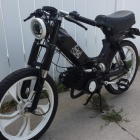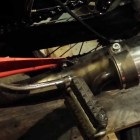Scooters and Mopeds, What’s the difference?
There’s often confusion surrounding what exactly is a moped and what’s a scooter. Most of the confusion stems from the way states license and define these vehicles and well frankly what they actually are. Licensing definitions and laws very from state to state so for the sake of this post I’m just using Minnesota’s laws.
In Minnesota a moped or adults electric scooter is defined as a two wheeled vehicle 49 cc’s or less, is unable to go faster then 30 mph on a level plain and utilizes an automatic transmission. According to Absolutereg.co.uk, if the vehicle doesn’t meet these criteria it’s considered a Motorcycle by MN state law and the driver must have a motorcycle endorsement or permit in order to operate it. A vehicle classified as a motorcycle also gets different license plates (Moped plates end with MP and motorcycle plates end with MG). The titles also differ in that with a motorcycle then VIN number on the frame of the machine and the serial number on the engine are recorded, on a moped on the frame VIN is tracked.
So using the laws there is no need to really separate out a moped from a scooter. As long as the vehicle conforms to their classifications they really don’t need to worry if their terminology is correct. The laws are good for defining what a machine is in terms of safety and that the driver is capable of operating it. What they don’t do is describe what the vehicle actually is in proper terminology.
Mopeds
Tomos MopedWhat truly makes a machine a moped is really right in the name. “Mo” for motor and “ped” for pedals. A true moped typically resembles a cross between a bicycle and a motorcycle. They can be belt driven or chain driven. For the most part they all utilize automatic transmissions, but I have seen some older machines that are not automatics. They typically have a 50 cc engine on them stock but there are a wide array of manufactures that make cylinder kits to bump up the displacement of the machines to 64 cc,70 cc,80 cc’s etc. When you put one of these kits on a bike it doesn’t magically transform into a motorcycle, it’s still a moped in appearance and operation. Mopeds for the most part are universally 2-stroke engines as well.
One thing to note is that there are also motor kits you can add on to a normal bicycle. Opinions differ, but I think you could also classify these machines as mopeds. If you look at some of the early mopeds, Motobecanes for instance are basically just that, a bicycle with a motor.
Motorized BicycleAn Old Motobecane, Not A Huge Difference From The Motorized Bicycle
Nopeds
A subset of mopeds, these have a bicycle like frame but have no pedals. One of the most popular examples of a Noped would be the Yamaha QT50. Also when the pedals are removed from a moped it’s often referred to as a noped.
Scooters
Yamaha Zuma 125A scooter is considered a two wheeled vehicle with smaller tires (around 10″-12″s), a built in front fairing, and your feet generally sit on a platform between the steering assembly and the seat. The rear wheel is generally belt driven with an automatic CVT style transmission. Some of the older scooters, vespas for example sometimes came equipped with a three speed manual transmission.
Suzuki Burgman 400As far as engines the majority of scooters use a 50 cc engine. They can be found in both 2 stroke and 4 stroke variations. Stock engine sizes can be found much higher then 50 cc’s though. 125 cc and 150 cc machines are very common as well. Honda Silverwings, Suzuki Burgmanns and a variety of chinese scooters have stock engine that are much larger in the 250cc to 400cc range. Again just because the engine of one of these machines cross the 50cc line it doesn’t magically transform into a motorcycle. It still operates in the exact same way it just goes faster.




